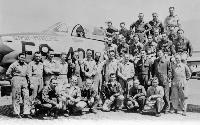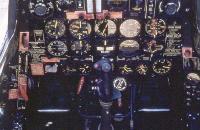Фотографии
-
The opposition - the Mikoyan-Gurevich MiG-15 was a quantum leap from the World War Two-vintage prop-driven aircraft initially fielded by the North Koreans. This example, “Blue 823” (c/n 108023) of the 176th GIAP based at Antung, was damaged during a B-29 raid on bridges over the Yalu on April 12, 1951, in which F-84Es were used for close support.
Самолёты на фотографии: МиГ МиГ-15 / И-310 - Россия - 1947
-
The 27th FEW was initially drafted into action in Korea to protect Boeing B-29s from the defending North Korean fighters. This example, 44-87734 Double Whammy, was operated by the 19th Bomb Group, the first B-29 unit to see combat in Korea, and was lost as the result of a runaway prop shearing the fuselage in January 1952.
Самолёты на фотографии: Boeing B-29 Superfortress - США - 1942
-
Регистрационный номер: FS-420-A Thunderjet 49-2420 at a base in South Korea while operating with the 524th FES. This F-84E went on to serve with the 136th FBW in Korea, and was lost with its pilot, Capt Herbert Ritter, when it was shot down by a MiG-15 on October 1, 1951.
Самолёты на фотографии: Republic F-84 Thunderjet - США - 1946
-
Lieutenant Jacob Kratt Jr of the 523rd FES was awarded the Silver Star in June 1951 for his actions on January 23, 1950, during which he shot down two MiG-15s while providing top cover for low-level attacks on Sinuiju by the 522nd and 524th FESs. His Silver Star citation praises his ‘‘aggressiveness, determination and unswerving devotion to duty”.
Самолёты на фотографии: Republic F-84 Thunderjet - США - 1946
-
Next stop Japan - Republic F-84E Thunderjets of the 27th Fighter Escort Wing (FEW) aboard the USS Bataan at San Diego, California, in late November 1950, before their sea journey to Yokosuka in support of operations in Korea.
Самолёты на фотографии: Republic F-84 Thunderjet - США - 1946
-
Регистрационный номер: FS-157-A An F-84E of the 522nd FES departs Itazuke AB in Japan loaded with 1,000 lb general-purpose bombs. It would complete its bombing mission over North Korea, land and refuel at a base in South Korea, complete a second mission and head back to Itazuke.
Самолёты на фотографии: Republic F-84 Thunderjet - США - 1946
-
Регистрационный номер: FS-408 In early 1951 the 27th FEW’S strategy was to send two squadrons of bomb-laden F-84s to attack the target, with the third squadron providing top cover. To get to the bombers the MiGs would have to fight through the defending squadron. This 522nd FES F-84E, fitted with long-range fuel tanks, is seen at a base in South Korea in early 1951.
Самолёты на фотографии: Republic F-84 Thunderjet - США - 1946
-
Регистрационный номер: FS-333 An F-84E of the 522nd Fighter Escort Squadron (FES) up over the Sea of Japan on a test flight after routine maintenance.
Самолёты на фотографии: Republic F-84 Thunderjet - США - 1946
-
Регистрационный номер: FS-083 Thunderjet 51-1083 of the 524th FES returns from a combat mission over North Korea in the early spring of 1951. This aircraft was one of many left behind when the 27th FEW left Korea in July 1951. On January 7, 1953, while serving with the 58th Fighter Bomber Group (FBG), it was hit by anti-aircraft fire and damaged beyond repair during a forced landing at K-14 Kimpo.
Самолёты на фотографии: Republic F-84 Thunderjet - США - 1946
-
Регистрационный номер: FS-426 Armourers work on servicing the 0-5in machine-guns of a 522nd FES Thunderjet at Taegu in February 1951. The F-84E could also carry 4,500 lb (2,040 kg) of bombs or 32 x 0-5in rocket projectiles.
Самолёты на фотографии: Republic F-84 Thunderjet - США - 1946
-
Регистрационный номер: FS-407 A 522nd FES pilot poses beside his F-84E in the early summer of 1951. Each of the 27th’s units had a signature colour; the 522nd’s was red, the 523rd’s was yellow and the 524th’s was blue.
Самолёты на фотографии: Republic F-84 Thunderjet - США - 1946
-
Humid conditions during the Korean summer made it difficult for the Thunderjets to leave the ground with a heavy load. Here a pair of 522nd F-84s get off at K-2 Taegu with the help of jet-assisted take-off (JATO) rocket bottles in 1951.
Самолёты на фотографии: Republic F-84 Thunderjet - США - 1946
-
Регистрационный номер: FS-393 The blue trim on this F-84E at Itazuke in early 1951 marks it out as belonging to the 524th FES. The markings were essentially the same for all 27th FEW F-84s, but in different colours.
Самолёты на фотографии: Republic F-84 Thunderjet - США - 1946
-
The view from the office - a group of 27th FEW Thunderjets patrol deep into North Korea while protecting a low-level strike force of North American F-51 Mustangs. The long-range fuel tanks attached to the inner wings were rather inelegant, but provided vital loiter time for extended missions in support of the “mud-movers” below.
Самолёты на фотографии: Republic F-84 Thunderjet - США - 1946
-
Регистрационный номер: FS-404 Pilots of the 522nd FES pose beside F-84E serial 49-2404 Gypsy From Po’Keepsie, at Taegu in the spring of 1951. Kneeling third from right is Lt-Col John W. Lafko, the 522nd’s Commanding Officer, who completed 134 combat missions over North Korea. The aircraft was lost on a strafing run in North Korea the following March.
Самолёты на фотографии: Republic F-84 Thunderjet - США - 1946
-
The snug office of the F-84E. Although nicknamed the “Lead Sled” owing to its ground-gripping long take-off runs, the F-84E was nevertheless popular with its pilots, having the characteristic ruggedness of a Republic design.
Самолёты на фотографии: Republic F-84 Thunderjet - США - 1946
-
As the conflict progressed, the quality of North Korea ’s defensive firepower increased dramatically, with sophisticated Chinese anti-aircraft artillery being drafted in. This 524th FES Thunderjet managed to make it back to Taegu with a sizeable part of the fin and rudder missing.
Самолёты на фотографии: Republic F-84 Thunderjet - США - 1946
-
В этот раз "Тандерджету" повезло дотянуть до базы
Tangling with MiG-15s proved dangerous at any altitude. This 522nd FES F-84 was on the receiving end of a MiG-15’s 37mm cannon during a low-level chase, but managed to limp back to Taegu with a damaged tailpipe in May 1951.Самолёты на фотографии: Republic F-84 Thunderjet - США - 1946
Статьи
- -
- ??? - David Lockspeiser: 1927-2014
- A.Steenbeck - Lowengeschwader's Big Bang
- B.Dunnell - Flying the Pucara
- D.Gordon - Exercise Shiksha: sharpening India's cold war claws
- F.Merriam - "Better to be Born Lucky than Rich..." /Echoes from Dawn Skies/ (3)
- K.Brookes - Merlin Magic at Farnborough
- M.Goodall - Pemberton Billing an the Four-Winged Farrago
- N.Helmo-Larsen - Who needs a pilot?
- P.Davidson - Off the Beaten Track...
- P.Jarrett - Lost & Found
- P.Jarrett - The Ugly Thuth?
- R.Mulder - Capital Gains: Oslo-Fornebu airport 1934-40
- R.Riding - The Aeroplane that Flies Itself
- R.Tisdale, A.Vercamer - Before & After
- W.Thompson - Distant Thunder

















